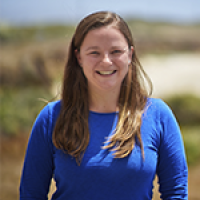
VIMS Assistant Professor Emily Rivest and her graduate students work with regional high schools to develop data collection programs that integrate Chesapeake Bay water quality (specifically carbonate chemistry) and oyster ecology data that will drive student led research.
The scientists are working with two teachers and their students in Tidewater, VA to field-test a citizen science protocol for collecting paired data that describes water quality and oyster performance. The compiled dataset addresses the larger question: how does oyster performance correlate with environmental conditions? Each high school has three sites along the Chesapeake Bay or its tributaries where measurements of water quality and oyster growth measurements are collected on a weekly or monthly basis. Students collect data via deployed temperature loggers, handheld devices, and preserved water samples for chemical analysis. Juvenile oysters have been deployed, and students measure their growth using calipers and photography. The data will be analyzed for a correlation between oyster growth and water quality and to compare the two methods for measuring oyster size.
